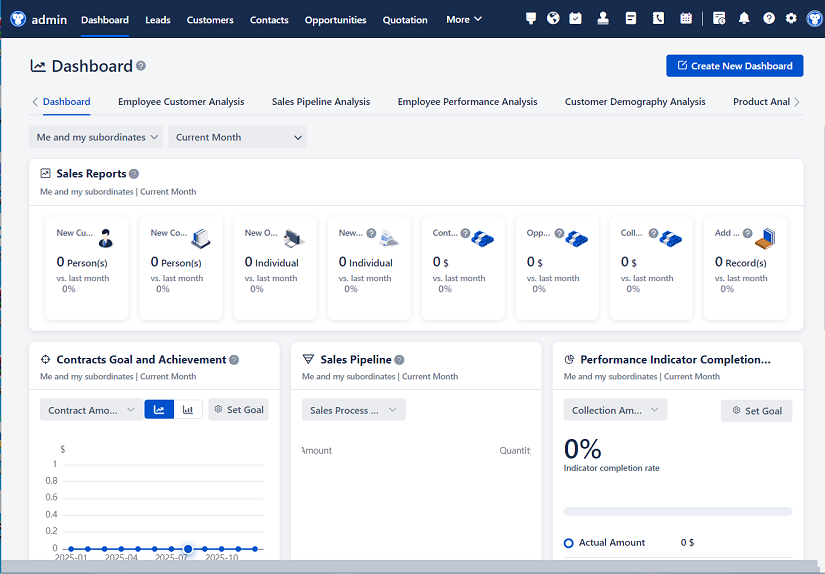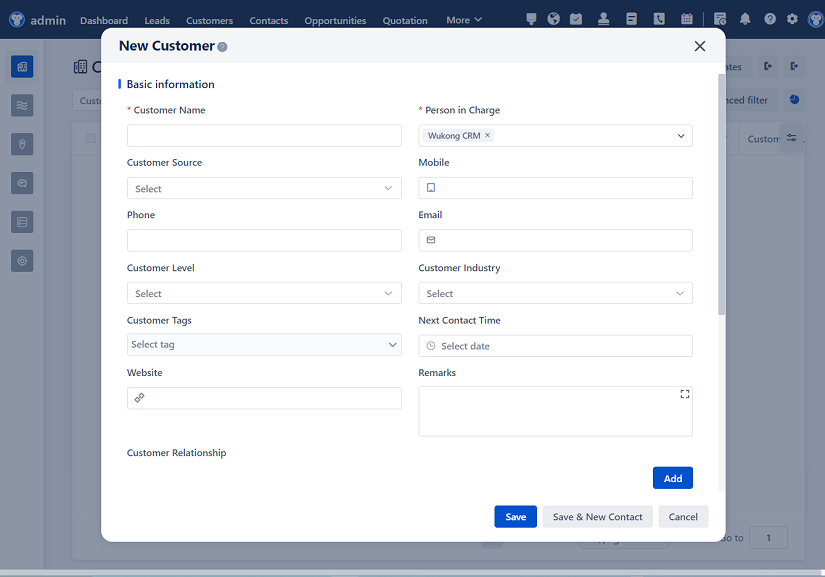
△Click on the top right corner to try Wukong CRM for free
Alright, so you're thinking about setting up a really solid CRM (Customer Relationship Management) system, huh? That's a great move! It can totally transform how your business interacts with customers and, trust me, it's worth the effort. But where do you even start? Well, let’s break it down into some manageable steps.

First things first, you need to figure out what exactly you want from this CRM system. I mean, think about it—what are your goals? Are you looking to improve customer service, boost sales, or maybe just get a better handle on all that data you've got floating around? Take a moment to sit down and jot down what you’re hoping to achieve. This will help you pick the right features and functions for your CRM.
Now, once you’ve got a clear idea of what you want, it’s time to do a bit of research. There are tons of CRM systems out there, and they all have their own strengths and weaknesses. Some are super user-friendly, while others might be more robust but a bit trickier to navigate. You’ll want to look at reviews, talk to other businesses in your industry, and maybe even try out a few free trials. Trust me, taking the time to find the right fit is crucial.
Okay, so you’ve done your homework and picked a CRM system. The next step is to get everyone on board. I know, I know, change can be tough, especially when it comes to new technology. But here’s the thing: if you involve your team from the beginning, they’re more likely to embrace it. Maybe set up a meeting to introduce the new system, explain why it’s important, and show them how it’s going to make their lives easier. And hey, if you can, offer some training sessions. People are more likely to use something if they feel confident about it.
Speaking of training, don’t skimp on this part. A CRM system is only as good as the people using it, so make sure everyone knows how to use it properly. You might want to bring in an expert to run a workshop, or if that’s not in the budget, there are plenty of online tutorials and resources. The key is to make sure everyone feels comfortable and supported.
Now, let’s talk about data. Before you go live with your new CRM, you need to make sure all your existing customer data is clean and organized. This means getting rid of duplicates, updating old information, and making sure everything is accurate. It might seem like a pain, but trust me, it’s worth it. A CRM system is only as good as the data it contains, and if your data is a mess, well, you’re not going to get the most out of your system.
Once your data is all sorted, it’s time to start customizing your CRM. Most systems these days are pretty flexible, so you can tailor them to fit your specific needs. Maybe you want to create custom fields, set up automated workflows, or integrate with other tools you’re already using. The sky’s the limit, really. Just remember, the goal is to make the system work for you, not the other way around.
Alright, so you’ve got your CRM up and running, and everyone’s using it. Great job! But here’s the thing: a CRM system isn’t a set-it-and-forget-it kind of deal. You need to keep an eye on it and make sure it’s working the way it should. Set up regular check-ins to see how things are going, and be open to making adjustments. Maybe you’ll find that certain features aren’t being used, or that there are new ones you’d like to add. The key is to stay flexible and be willing to adapt.
Another thing to keep in mind is that a CRM system is a tool, not a magic wand. It’s there to help you, but it’s still up to you and your team to use it effectively. So, make sure you’re actually using the data and insights it provides to make informed decisions. For example, if you notice that a particular marketing campaign is really resonating with your customers, double down on it. Or if you see that a certain segment of your customer base is having issues, reach out and see how you can help. The point is, the CRM is there to give you the information; it’s up to you to act on it.
One last thing: communication is key. Make sure you’re keeping the lines of communication open between different departments. A CRM system can be a great way to break down silos and get everyone on the same page. For example, if your sales team is using the CRM to track leads, make sure the marketing team has access to that data too. This way, everyone can work together more effectively, and you’ll get a more holistic view of your customers.
So, there you have it—a step-by-step guide to setting up a robust CRM system. It might seem like a lot, but trust me, it’s totally doable. And the benefits are huge. You’ll have happier customers, more efficient processes, and a better understanding of your business. So, take a deep breath, roll up your sleeves, and get started. You’ve got this!

Q: What are the key steps to setting up a robust CRM system? A: The key steps include defining your goals, doing thorough research, getting your team on board, providing proper training, cleaning and organizing your data, customizing the CRM, and continuously monitoring and adjusting the system.
Q: How important is it to involve my team in the CRM setup process? A: Involving your team from the beginning is super important. It helps them understand the value of the CRM, makes them more likely to embrace the change, and ensures they know how to use the system effectively.
Q: Why is data cleaning and organization so crucial before implementing a CRM? A: Clean and organized data is essential because a CRM system is only as good as the data it contains. If your data is messy or inaccurate, you won’t be able to get the full benefits of the CRM, and it could even lead to poor decision-making.
Q: Can a CRM system be customized to fit my specific business needs? A: Absolutely! Most modern CRM systems are highly customizable. You can create custom fields, set up automated workflows, and integrate with other tools to make the system work exactly the way you need it to.
Q: How often should I review and adjust my CRM system after implementation? A: It’s a good idea to set up regular check-ins, maybe monthly or quarterly, to review how the CRM is working. This allows you to make any necessary adjustments and ensure the system continues to meet your evolving needs.
Related links:
Free trial of CRM
Understand CRM system
AI CRM Systems

△Click on the top right corner to try Wukong CRM for free